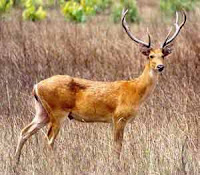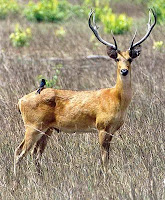Big Cats Too Near
It is a sad story, all the euphoria created by the Project Tiger is gone. Tiger lovers, conservationist, NGOs are having a nightmarish premonition - a mini doomsday. The leopard in India is facing the same fate, perhaps worst. All the attention is centered around the tiger and nothing wrong about it. But it is high time same status is provided to the leopard in India.
When the Nation talks about Cheetah relocation it only suggests that our conservation is tourism oriented and perhaps leaning on jingoistic pride. There is nothing wrong with well managed tiger tourism since its benefits are impressive. And there is nothing wrong with possessive approach towards our wild heritage ...but is this enough?
We who boast so much of belonging to an oldest civilization on Earth. Especially with all shorts of conservation ethos ingrained in the Vedas and Hindu scriptures. Yet we are struggling to save one of the most ecologically important animal on Earth.
In spite of all the efforts - lot many constructive - we are not succeeding in preserving tiger footsteps from vanishing. Why so? Perhaps if we delve deeper into conserving the leopard lot more truth will surface. In fact active leopard conservation will open more innovative methods to save the tiger.
The leopard is known to exhibit immense survival extinct, but in spite, it is loosing ground fast in India. The major conflict is with the our society that is concerned about itself and presumes ownership of the Earth as a human prerogative.
The man animal conflict as regards to the leopard is more intense than with the tiger. By natural instinct the animal avoids conflict with tigers and hence many are forced to survive in outer areas of our forests with dense human population.
Lets be sure human settlements near forest areas live with scant regard or even in abject fear of wild animals... more so due to myth, unseen fear and sometimes actual conflict and sufferings. That we have encroached in their land (other life forms) has become a hearsay. The perspective remains the same as it was whence the animals were declared vermin and shot ruthlessly by butchers of the past.
I have interacted with many villagers around the periphery of tiger habitats, most of them have no love for the tigers or leopards - expect those benefiting directly from their existence. We have to understand that they are in the same mold as lot many of us are...a snake to be conserved is fine ....as long as it is not in our garden or house. The tigers and leopards are very much in the garden of locals around the periphery of the reserves. The threat perception exists, walk down to a village where cattle lifter is present or human tragedy has occurred and you will soon find out. Locals can act as big deterrent to poachers.
Only people benefiting from tiger's existence have interest in its survival for the rest it is their own survival that matters and nothing else. (And oops! Tiger lovers, conservationists, NGO and all like minded people are sincerely making efforts to save the species in India).
Would the direct beneficiaries have the same feel for the leopard? Not so much since the animal is less publicized and less sought after as a visual delight. Let us be sure people rarely understand ecosystem and food chain concept...it is sentiments that are fueling their conservation ethos. And why not? A large number of people are acting as pressure groups today than earlier. This is thanks to tiger tourism. that imparts benefits to unemployed - as forest guides, resort workers, Jeep owners, accommodation providers, retailers and many others. An example of value added conservation for sure. (Ask a guide at Taj and you will know how much he values the monument.)
In recent news more than hundred fifty leopards have been poached or killed in India.
The news article will assure you that the
leopard is a neglected cousin. Perhaps if we strive hard to conserve this extremely beleaguered animal in India it may throw open new insights in big cat conservation as whole.
In the present circumstances tiger crisis reeks of multifarious angle - human society, democratic urgency, poaching, Chinese medicine (sic), inherent corruption, conflict and self centered priorities. Our attitude is shameless as perceiving the the Earth as our prerogative... take a peek in every day life opinions, it will confirm this.
Where does the buck stop! Will we frame rules that says this is our and this is theirs and this is for sharing. Properly defined extensive inviolate areas are key to wildlife conservation in India. Protected areas mind you cover barely two or three percent of 32 lakh sq km that is India.
Why properly defined? Anyone who has been to Kanha in earlier times knows that some areas were habitats of Indian wolf, hyena and other open country animals. The protection status was created totally bereft of the presence of these animals - areas were humans have moved in now. The animals are scarce now by all means.






















































